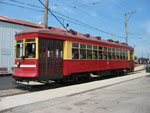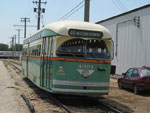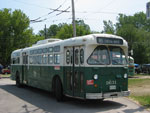A Brief History of Chicago Surface Lines
Public transportation began in Chicago in the mid 19th century. The first streetcars were horse-drawn and entered into service on April 25, 1859. The first line ran on State St. between Randolph and 12th Streets. The original streetcars were 12 feet long, held 18 passengers, and operated at 3mph. Over the next few years, several additional routes were added and by 1866 horse car service went as far as 39th Street.
1882 saw the introduction of cable cars in Chicago. Cable cars were much faster than horse cars, capable of speeds of up to 14mph. The first cable car line was on State Street north of 21st Street.

The first overhead trolley car went into service in 1890 on 93rd Street between Stony Island and South Chicago Avenue. Electrification of horse car and cable car routes was completed in 1906.
On February 1, 1914, all street railway companies in Chicago were unified under one management and became known as the Chicago Surface Lines. Prior to that date, service was provided by the following companies: Chicago Railways Co., Chicago City Railway Co., Calument & South Chicago Rv. Co., Souther Street Rv. Co., and Chicago and Western Rv. Co..
Motor bus service began in Chicago on August 11, 1927 when the first gasoline buses were placed into service on Diversey Avenue. This was followed by the introduction of trolley bus service on April 17, 1930.

In 1945, the Chicago Surface Lines purchased the “Green Hornet” streetcars, which were called so because of their speed and color. “Green Hornets” were the last order of streetcars in Chicago. Although faster than older streetcars, they were unable to handle traffic congestion and were not able to detour at will around blockades. This, along with changing economic conditions, eventually led to their retirement.
In 1945, the Chicago Transit Authority was created. On October 1, 1947, the Chicago Transit Authority took over all rapid transit and streetcar service in Chicago.
On June 22, 1958, streetcar service ended in Chicago. The last streetcar to operate was #7213, a “Green Hornet” streetcar, on the Wentworth line.

In 1961, the CTA purchased its first “New Look” (or “Fishbowl”) buses from GM. The New Look buses were more efficient than previous motor buses and nearly all were powered by diesel fuel. By 1976, all propane buses and trolleybuses were replaced with diesel-powered buses. “New Look” model buses remained in service until 1996.
In 1979, the CTA put into service the first 55 foot “articulated” buses. These buses were often known as the “Big Bend Bus” because of the bendable accordion-style portion near the center of the bus which allowed the bus to easily make turns.
In 1990, the CTA purchased its first wheelchair accessible buses from Transportation Manufacturing Corporation. In 1995, Chicago saw the introduction of the first low floor buses, which eliminate steps at the front of the bus in an effort to make the buses more accessible for wheelchairs and the elderly.
In 2006, the CTA purchased its first diesel-electric hybrid buses from New Flyer of America, Inc. Hybrid buses offer greater fuel efficiency than standard diesel buses and are more environmentally friendly due to reduced emissions.